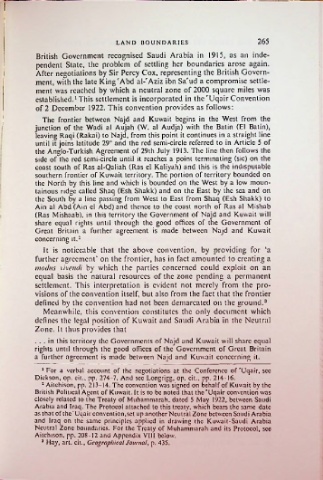Page 329 - The Arabian Gulf States_Neat
P. 329
LAND BOUNDARIES 265
British Government recognised Saudi Arabia in 1915, as an inde
pendent State, the problem of settling her boundaries arose again.
After negotiations by Sir Percy Cox, representing the British Govern
ment, with the late King'Abd al-fAziz ibn Sa'ud a compromise settle
ment was reached by which a neutral zone of 2000 square miles was
established.1 This settlement is incorporated in the'Uqair Convention
of 2 December 1922. This convention provides as follows:
The frontier between Najd and Kuwait begins in the West from the
junction of the Wadi al Aujah (W. al Audja) with the Batin (El Batin),
leaving Raqi (Rakai) to Najd, from this point it continues in a straight line
until it joins latitude 29° and the red semi-circle referred to in Article 5 of
the Anglo-Turkish Agreement of 29th July 1913. The line then follows the
side of the red semi-circle until it reaches a point terminating (sic) on the
coast south of Ras al-Qaliah (Ras el Kaliyah) and this is the indisputable
southern frontier of Kuwait territory. The portion of territory bounded on
the North by this line and which is bounded on the West by a low moun
tainous ridge called Shaq (Esh Shakk) and on the East by the sea and on
the South by a line passing from West to East from Shaq (Esh Shakk) to
Ain al Abd (Ain el Abd)and thence to the coast north of Ras al Mishab
(Ras Mishaab), in this territory the Government of Najd and Kuwait will
share equal rights until through the good offices of the Government of
Great Britain a further agreement is made between Najd and Kuwait
concerning it.2
It is noticeable that the above convention, by providing for ‘a
further agreement’ on the frontier, has in fact amounted to creating a
modus vivendi by which the parties concerned could exploit on an
equal basis the natural resources of the zone pending a permanent
settlement. This interpretation is evident not merely from the pro
visions of the convention itself, but also from the fact that the frontier
defined by the convention had not been demarcated on the ground.3
Meanwhile, this convention constitutes the only document which
defines the legal position of Kuwait and Saudi Arabia in the Neutral
Zone. It thus provides that
. . . in this territory the Governments of Najd and Kuwait will share equal
rights until through the good offices of the Government of Great Britain
a further agreement is made between Najd and Kuwait concerning it.
1 For a verbal account of the negotiations at the Conference of 'Uqair, sec
Dickson, op. cit., pp. 274-7. And sec Longrigg, op. cit., pp. 214-16.
2 Aitchison, pp. 213-14. The convention was signed on behalf of Kuwait by the
British Political Agent of Kuwait. It is to be noted that thc'Uqair convention was
closely related to the Treaty of Muhammarah, dated 5 May 1922, between Saudi
Arabia and Iraq. The Protocol attached to this treaty, which bears the same date
as that of thc'Uqair convention,set up another Neutral Zone between Saudi Arabia
and Iraq on the same principles applied in drawing the Kuwait-Saudi Arabia
Neutral Zone boundaries. For the Treaty of Muhammarah and its Protocol, see
Aitchison, pp. 208-12 and Appendix VIII below.
3 Hay, art. cit., Geographical Journal, p. 435.

